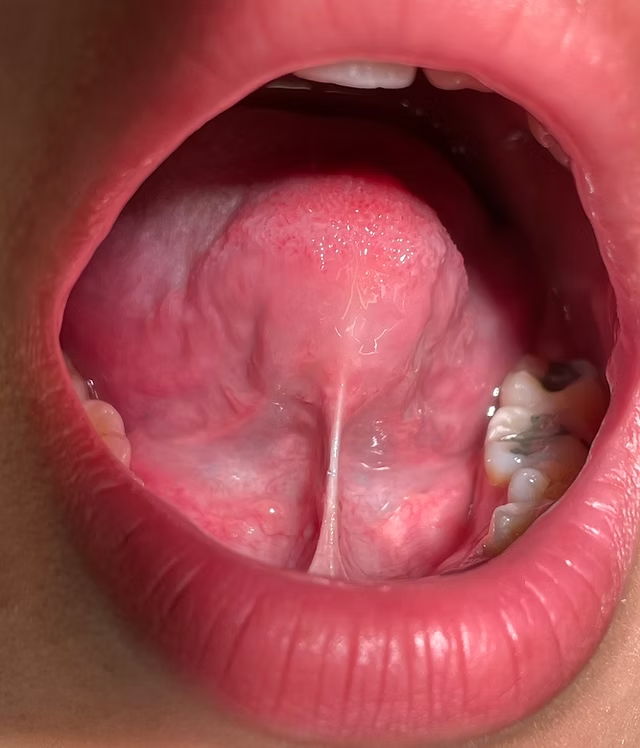Tongue Tie
- Irene Michelle Iancu
- Oct 25, 2024
- 3 min read
Updated: May 26
Some tongue ties are not easily spotted and can be called “Posterior tongue ties” often only diagnosed by a trained dental professional.”
What is a tongue tie?
A tongue tie, or ankyloglossia, is a condition where the band of tissue under the tongue, called the frenulum, is abnormally short or tight. This restriction limits the tongue's range of motion, making it difficult for the individual to move the tongue freely. In infants, a tongue tie can interfere with breastfeeding, causing feeding difficulties and discomfort for both the baby and the mother.
In older children and adults, it can lead to issues with speech articulation, swallowing, and oral hygiene. The condition can also impact the development of the dental arch and overall oral health. Treatment often involves a procedure called a frenectomy, where the frenulum is cut to release the tongue’s movement, followed by exercises to improve tongue function and alleviate related issues.
Myofunctional therapy can be highly beneficial in managing and correcting the effects of a tongue tie, especially when combined with appropriate medical procedures. This therapy involves exercises designed to enhance the strength and flexibility of the tongue, improving its mobility for better speech, swallowing, and oral hygiene. It also focuses on coordinating the movements of the tongue, lips, and jaw, which can help alleviate compensatory habits such as improper chewing or swallowing that develop due to the tongue tie. Post-surgically, after a frenectomy or similar procedure to correct the tongue tie, myofunctional therapy supports the healing process by ensuring the new range of motion is utilized effectively and maintaining the improvements gained from surgery. Additionally, it addresses related issues like speech difficulties, oral hygiene problems, and potential orthodontic concerns by retraining muscle function to provide a comprehensive approach to resolving these challenges.
If a tongue tie is not corrected in adulthood, it can lead to a range of issues affecting oral health, speech, and overall quality of life.
Here’s what can happen:
Speech Difficulties: A restricted tongue can impact the ability to articulate certain sounds properly, leading to speech problems such as difficulty pronouncing "t," "d," "l," and "r" sounds. This can affect communication and confidence.
Eating and Swallowing Issues: Difficulty with proper tongue movement can complicate chewing and swallowing, potentially leading to discomfort, choking, or difficulty managing certain foods.
Oral Hygiene Problems: Limited tongue mobility can make it challenging to clean the mouth effectively, increasing the risk of plaque buildup, cavities, and gum disease.
Dental and Orthodontic Problems: A tongue tie can contribute to improper alignment of the teeth and bite issues. It may also hinder the effectiveness of orthodontic treatments by affecting the position of the tongue and dental arch development.
Jaw Pain and TMJ Disorders: The strain from compensating for limited tongue movement can lead to jaw discomfort or temporomandibular joint (TMJ) disorders, causing pain, clicking, or difficulty with jaw movement.
Sleep Issues: In severe cases, a tongue tie may contribute to obstructive sleep apnea or other sleep-related problems due to restricted airway space.
Postural and Musculoskeletal Issues: The restriction can affect posture and contribute to musculoskeletal problems, such as neck and shoulder tension, as the body compensates for the limited tongue movement.
Addressing a tongue tie early can prevent these complications and improve overall oral health and quality of life. For adults experiencing issues related to a tongue tie, consulting with a healthcare professional for evaluation and potential treatment is recommended.
Procedures to Correct Tongue Tie:
Frenectomy: This is a common surgical procedure where the tight or short frenulum (the band of tissue under the tongue) is cut to release the tongue’s range of motion. It can be done using various methods, including a scalpel, laser, or electrocautery. This procedure is often performed in infants, but it can also be done in older children and adults.
Frenuloplasty: This is a more extensive surgical procedure than a frenectomy. It involves not only cutting the frenulum but also repairing and reconstructing it to allow for a greater range of motion and to address more severe cases of tongue tie.
Laser Therapy: Laser frenectomy uses a laser to cut the frenulum, which can be less invasive and cause less discomfort than traditional methods. It often results in a faster healing time and minimal bleeding.
Post-Surgical Therapy: Following surgical correction, a period of myofunctional therapy is often recommended to optimize healing, ensure proper tongue movement, and prevent the recurrence of the tongue tie.
By combining myofunctional therapy with these corrective procedures, individuals can effectively address the issues related to a tongue tie, improving overall oral function, speech, and quality of life.



